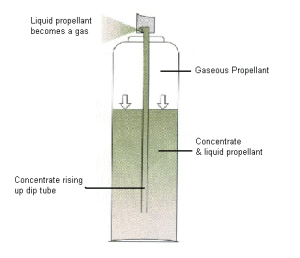
How Aerosols Work
As pictured, the product is disolved or suspended in a liquid solvent. A liquified gas is usually used as a propellant.
In a typical aerosol, some of the propellant exists as a gas under pressure above the product. This gas pushes down on the liquid, forcing it up through the dip tube and out the valve when it is opened. The liquid is a mixture of product and liquified gas.
As it is released, the gas evaporates from the liquid in the container causing constant performance and pressure within the aerosol.
When the liquid mixture is released from the aerosol, the liquid propellant becomes a gas and helps break up the product into a fine mist. In foams like mousse and aftershave, the liquid gas forms bubbles, making the product expand as it is released from the aerosol.
The amount of propellant in aerosols differs depending on the product. For example: for fine mists, a larger amount is used than in foams, etc.
For more information, go to How Stuff Works.

How Aerosols Work
